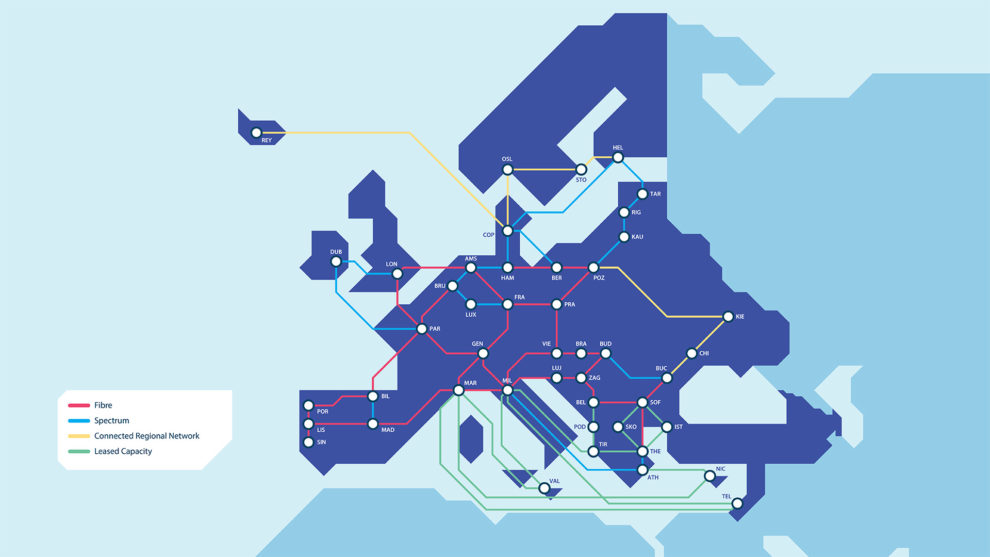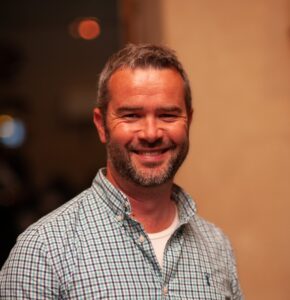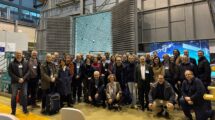GÉANT’s exciting next-generation network – planned, procured, and being built under the EC-funded GN4-3N Project – was launched at the Closing Plenary of TNC22 to the community that has driven and guided it throughout. In this second part of a series of interviews first published in the CONNECT 40 magazine, we highlight some of the people behind this project.
Words: Paul Maurice and Karl Meyer, GÉANT | Second part in a series of interviews on the GN4-3N Project. Part 1 here.
With 28 routes deployed (and 14 of those now in operation) two routes in deployment, 12 routes in the connectivity delivery phase, seven routes in the response evaluation or contract finalisation stage, and two routes in the active tendering phase, it’s easy to see how quickly this complex project is moving.
Despite the challenges of the pandemic and its impact on travel, and despite a global semiconductor shortage affecting the delivery of new equipment, everybody involved in this project is continuing to dig deep and push this ambitious and complex project forward.
At the time of writing (early May) 18 countries are now connected to the new network, there are 209 physical spans, with 294 new Infinera nodes built, and over 14,500km of dark fibre has been lit.
In parallel to this work, the focus over the summer will be on the decommissioning of legacy equipment and the migration of new routes, ensuring operational savings are realised and the project budget optimised.
Ahead of its showcase at TNC22, CONNECT spoke to several of the people involved in this project to understand the background and the technical side of the project, but also to see how far we’ve come, what’s coming next, and what the community can expect from the next-generation GÉANT network.
Paul Maurice spoke to Paul Shelswell, GÉANT’s Programme Manager for GN4-3N, to get a snapshot of where we are in the project timescale.

Paul, you’re responsible for keeping this project firmly on schedule and overseeing every detail. Where do we sit on the project timeline now?
We are at a very interesting point in the overall project, where we have built a significant part of the new network and are now using a large section of the new GN4-3N infrastructure in the GÉANT IP backbone network.
This has allowed a number of existing fibre routes and leased services to be ceased and the related equipment decommissioned. This means that the planned operating expense (OPEX) savings are now starting to be realised based on the longer-term funding structure (noted in Sebastiano’s interview).
The project has also been granted a 12-month extension by the EC to allow the extended project scope to be completed. This extended scope will provide upgraded connectivity services to more NRENs as part of the GÉANT backbone expansion and is possible based on the procurement savings achieved to date. We are now working through the market engagement and procurement activities and I’m expecting that these final routes will move into the build phase during Q2 2023.
What have been the most challenging aspects of the project so far, and how were they overcome?
It’s fair to say that we have had a number of challenges over the 40 months of the project so far. The biggest challenge has been the COVID-19 pandemic that started just before the first deployment activities got underway in the Iberian Peninsula.
The widespread lockdowns and restrictions added complexity to build planning and activities, but we were fortunate to work with the Infinera project team and their very flexible deployment partners to minimise any impacts.
Deployment engineers were faced with last minute travel changes and multiple isolation periods but due to the large pool of highly experienced engineers, we were able to work with the Infinera team to minimise delays by using a larger engineering team. On cross border routes, we also used multiple teams working from each end of the route to avoid having engineers travel across land borders which was not always possible.
Another challenge has been the extended hardware lead times for Infinera hardware due to the global semiconductor shortage – a knock-on impact of COVID-19. We have seen lead times more than double since the first hardware was ordered in 2020 and we are currently looking at a 26-week lead time. To minimise the impact of extended lead times, we are ordering hardware earlier in the process than we normally would – this introduces an element of risk as we do not always have the full fibre data available when the Infinera order is placed, but we have added hardware return clauses in the supply contracts to mitigate the risk of ordering so far in advance.
And what have been the highlights so far?
One of the highlights has been to use the new Infinera Network Management System to visually see how quickly the new network build has progressed across Europe, from the start in the Iberian Peninsula in Q3 2020 to the more than 14,000km of lit fibre that we now have.
At the same time, it’s been very pleasing to see the network topology map display on the existing Network Management System shrink in size as services have been migrated to the new network and existing services have been decommissioned from the network.
Another challenge has been the interaction and cooperation between GÉANT and the NREN community in many areas of the project. This starts with the NIAC where network design options are reviewed and endorsed, through to the innovative solutions deployed in the network using NREN infrastructure.
A good example of this has been in the Iberian Peninsula where we were able to deliver fibre connectivity between Portugal and Spain using a mixture of NREN infrastructure and commercial connectivity solutions. We are now also starting to work on the first leased spectrum solutions in the network using NREN managed optical DWDM systems. This work will continue over the next 12 months.
How has the project evolved since its start? Have we been able to extend the scope of it?
The project has evolved in size and complexity since the first reference design was produced back in 2017 to support early design and market engagement activates. With the GN4-3N extended scope, we are now looking to provide the minimum 100G connectivity offering in more countries. This has been made possible by the procurement savings achieved via the procurement process compared to the original GN4-3N network design and associated budget.
The project has been extended to the end of 2023 and I expect that the final deployment and integration activities will be completed during Q3 2023.
What do you see as most important over the next 12-18 months to ensure we deliver on time?
The most important tasks over the next 12-18 months are to ensure that we continue to maintain good progress in moving new GN4-3N routes into the GÉANT production network which will then allow the existing routes, typically with higher OPEX costs, to be ceased.
I’m confident that based on the good teamwork, well defined processes and experience gained since the start of GN4-3N deployments in 2020, the build out of the remaining new routes should go reasonable smoothly, but the focus must be on moving the new infrastructure into production service as soon as possible but in a well-controlled manner.
This article is featured on CONNECT40! Read or download the full magazine here







